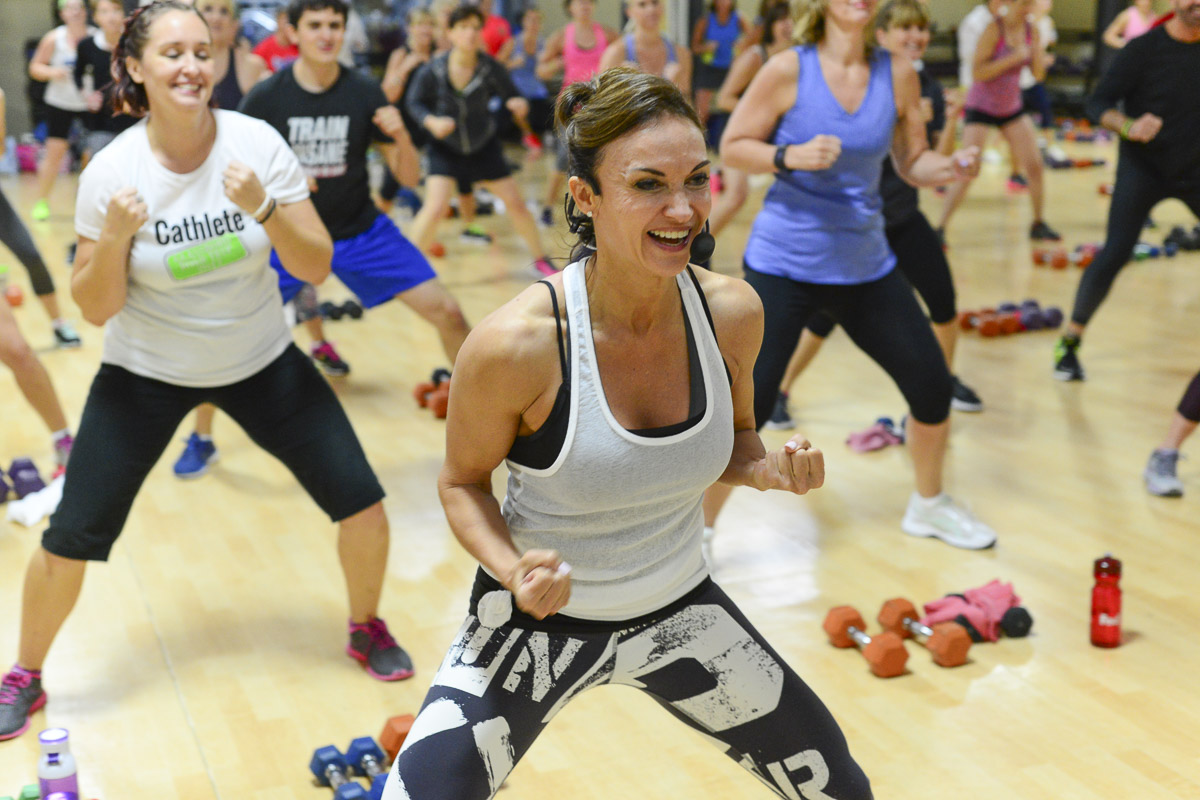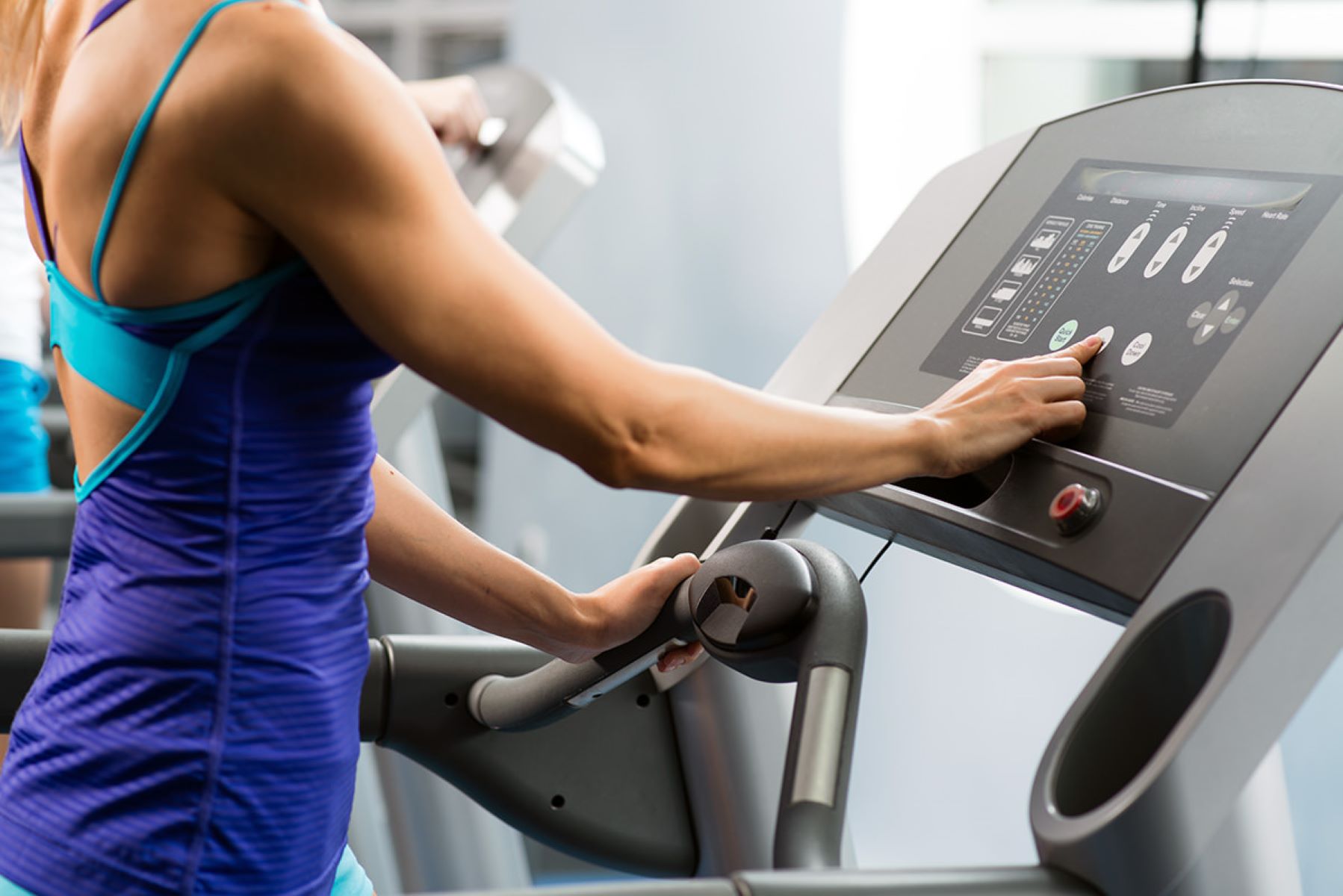Home>Misc>Featured>What Does High Intensity Interval Training Do


Featured
What Does High Intensity Interval Training Do
Modified: March 2, 2024
Discover the benefits of featured High Intensity Interval Training (HIIT) workouts and how they can transform your fitness routine.
Introduction
Welcome to the world of High Intensity Interval Training (HIIT), a fitness trend that has taken the exercise world by storm. Whether you are a seasoned athlete or just starting your fitness journey, HIIT can offer numerous benefits to help you achieve your health and fitness goals.
HIIT is a form of cardiovascular exercise that involves short bursts of intense activity followed by periods of rest or active recovery. This type of training is designed to push your body to its limits and maximize calorie burn in a short amount of time. Unlike traditional steady-state cardio exercises, like running on a treadmill for an hour, HIIT workouts are short, intense, and highly effective.
Over the years, HIIT has gained popularity due to its ability to deliver exceptional results in a fraction of the time compared to other exercise methods. By incorporating HIIT into your fitness routine, you can elevate your cardiovascular endurance, burn more fat, boost your metabolism, and improve your overall fitness level.
In this article, we will explore the various benefits of High Intensity Interval Training and how it can positively impact your cardiovascular health, fat burning abilities, muscle development, and more. We will also provide important considerations and safety precautions to keep in mind when engaging in HIIT workouts.
So, whether you are looking to shed those extra pounds, increase your athletic performance, or simply improve your overall fitness, HIIT may just be the workout you’ve been searching for. Strap on your workout shoes and get ready to discover the incredible benefits of High Intensity Interval Training.
Definition of High Intensity Interval Training (HIIT)
High Intensity Interval Training (HIIT) is a form of exercise that alternates between short bursts of intense activity and periods of rest or active recovery. It involves pushing your body to its maximum capacity during the intense intervals, followed by brief recovery periods to allow your body to catch its breath.
The intense intervals typically last anywhere from 20 to 60 seconds and can include exercises such as sprints, jump squats, burpees, or kettlebell swings. These bursts of high-intensity exercise are performed at near-maximum effort, elevating your heart rate and challenging your muscles.
After each intense interval, a period of rest or active recovery is incorporated. This allows your heart rate to drop, your breathing to regulate, and your muscles to recover partially before the next intense interval.
The key to effective HIIT workouts is to maintain a high level of effort and intensity throughout the entire workout. It is the combination of the intense intervals and the brief recovery periods that makes HIIT so efficient and beneficial.
HIIT can be performed using various exercises and equipment, making it versatile and easily adaptable to different fitness levels and preferences. It can be done with bodyweight exercises, weights, resistance bands, or cardio equipment such as a treadmill or stationary bike.
Overall, High Intensity Interval Training is a highly efficient and time-effective workout method that can deliver impressive fitness results. By challenging your body with intense bursts of exercise and allowing it to recover in short periods, you can push your limits and achieve your fitness goals.
Benefits of High Intensity Interval Training
High Intensity Interval Training (HIIT) offers a wide range of benefits that make it an attractive workout option for individuals of all fitness levels. Let’s explore some of the key advantages of incorporating HIIT into your fitness routine:
1. Improves Cardiovascular Health: HIIT workouts challenge your cardiovascular system, helping to improve heart health and increase your aerobic capacity. The intense bursts of exercise followed by brief recovery periods increase your heart rate and allow your cardiovascular system to adapt, leading to improved endurance and a more efficient heart.
2. Increases Fat Burning: HIIT is highly effective for burning fat and losing weight. The intense intervals push your body to its limits, triggering a higher metabolic rate during and after the workout. This results in more calories burned and an increased rate of fat oxidation, leading to improved body composition.
3. Boosts Metabolism: HIIT workouts have been shown to elevate your metabolism for hours after your workout. This is known as the “afterburn effect” or excess post-exercise oxygen consumption (EPOC). HIIT stimulates the production of human growth hormone (HGH) and increases your resting metabolic rate, leading to increased calorie burn throughout the day.
4. Enhances Endurance and Stamina: Regular HIIT workouts can significantly improve your aerobic and anaerobic endurance. The intense intervals challenge your muscles and cardiovascular system, allowing you to increase your endurance capacity over time. This can benefit athletes and individuals participating in sports or activities that require sustained effort.
5. Builds Lean Muscle Mass: While HIIT primarily focuses on cardiovascular fitness, it can also help you build lean muscle. The intensity of the exercises during the intervals stimulates muscle growth and activates fast-twitch muscle fibers. This can result in increased muscle definition and a more toned physique.
6. Time-Efficient Workout Option: One of the greatest advantages of HIIT is its time efficiency. HIIT workouts are typically shorter in duration compared to steady-state cardio exercises. You can achieve significant fitness gains in as little as 20 minutes of HIIT, making it ideal for those with busy schedules.
7. Appropriate for Various Fitness Levels: HIIT workouts can be modified to accommodate different fitness levels. The intensity and duration of the intervals can be adjusted to suit your fitness level, making it accessible for beginners and challenging for advanced athletes.
These are just a few of the benefits that High Intensity Interval Training can offer. Whether you are looking to improve your cardiovascular health, burn fat, increase endurance, or build muscle, incorporating HIIT into your fitness routine can help you achieve your goals efficiently and effectively.
Improves Cardiovascular Health
One of the key benefits of High Intensity Interval Training (HIIT) is its ability to improve cardiovascular health. HIIT workouts are designed to challenge and strengthen your heart and lungs, leading to enhanced overall cardiovascular fitness.
During a HIIT workout, the intense intervals push your heart rate to near-maximum levels. This increases the demand for oxygen and causes your cardiovascular system to work harder to deliver oxygen-rich blood to your muscles. Over time, this repeated stress on your cardiovascular system leads to improvements in heart health.
HIIT helps to improve heart health in several ways:
1. Increases Heart Strength: During the intense intervals of HIIT, your heart needs to pump more blood to meet the increased oxygen demands of your muscles. This constant pushing strengthens your heart muscle, making it more efficient at pumping blood throughout your body.
2. Enhances Stroke Volume: Stroke volume refers to the amount of blood your heart can pump with each beat. HIIT workouts can help increase stroke volume, allowing your heart to deliver more oxygenated blood to your muscles with every beat.
3. Lowers Resting Heart Rate: Regular participation in HIIT can lead to a lower resting heart rate. This indicates that your heart is able to pump more blood with each beat, resulting in a more efficient cardiovascular system.
4. Improves Blood Pressure: HIIT has been shown to have a positive impact on blood pressure levels. Regular HIIT workouts can help lower blood pressure and improve the overall health of your cardiovascular system.
5. Enhances Aerobic Capacity: HIIT workouts challenge your body’s ability to process and utilize oxygen. As you consistently engage in HIIT, your body becomes more efficient at utilizing oxygen, leading to increased aerobic capacity. This means you can perform physical activities for longer periods without experiencing fatigue.
It’s important to note that while HIIT is highly effective for improving cardiovascular health, it is crucial to listen to your body and consult with a healthcare professional before starting any new exercise program, especially if you have pre-existing heart conditions.
Incorporating HIIT into your fitness routine can have a profound impact on your cardiovascular health. By participating in regular HIIT workouts, you can strengthen your heart, improve blood circulation, and enhance your overall cardiovascular fitness.
Increases Fat Burning
One of the most sought-after benefits of High Intensity Interval Training (HIIT) is its ability to significantly increase fat burning. HIIT workouts utilize intense bursts of exercise followed by short recovery periods to create a metabolic response in your body that can lead to accelerated fat loss.
HIIT is highly effective for fat burning due to several factors:
1. Elevated Calorie Burn: The intense nature of HIIT workouts leads to a significant increase in calorie burn during and after the workout. Even though HIIT sessions are typically shorter in duration, the intensity of the exercises raises your metabolic rate, causing your body to continue burning calories post-workout.
2. Enhanced Metabolic Rate: HIIT stimulates the production of growth hormone and boosts your resting metabolic rate. This means that even after you finish your workout, your body continues to burn calories at a higher rate, known as the “afterburn” effect or excess post-exercise oxygen consumption (EPOC).
3. Increased Fat Oxidation: HIIT has been shown to enhance the body’s ability to oxidize fat for fuel. By engaging in high-intensity exercises, your body depletes its glycogen stores and relies more on fat as a source of energy.
4. Preserves Muscle Mass: Unlike steady-state cardio exercises, which can lead to muscle loss, HIIT promotes the preservation of lean muscle mass. This is important during fat loss, as preserving muscle helps to maintain a higher metabolic rate and promote a more toned physique.
Research has consistently shown that HIIT can be more effective for fat burning compared to traditional steady-state cardio exercises, such as jogging or cycling at a moderate pace. In fact, studies have suggested that HIIT can lead to greater reductions in body fat percentage and abdominal fat compared to other types of cardio exercise.
It’s important to note that while HIIT can be highly effective for fat loss, it should be combined with a well-balanced diet and overall healthy lifestyle for optimal results. Additionally, it’s crucial to start HIIT gradually and listen to your body, as the high intensity can place significant stress on your joints and muscles.
Incorporating HIIT into your fitness routine can be a powerful tool for boosting fat burning and achieving your weight loss goals. By engaging in regular HIIT workouts, you can accelerate your metabolism, increase calorie burn, and shed unwanted body fat.
Boosts Metabolism
A major benefit of High Intensity Interval Training (HIIT) is its ability to boost your metabolism. Your metabolism refers to the chemical processes that occur in your body to convert food into energy. A faster metabolism means that you burn more calories throughout the day, even at rest.
HIIT workouts are highly effective at boosting metabolism due to several key factors:
1. Excess Post-Exercise Oxygen Consumption (EPOC): HIIT stimulates a phenomenon known as EPOC, also referred to as the “afterburn effect.” After a HIIT session, your body continues to burn calories at an elevated rate for hours, and in some cases, even up to 24 hours after the workout. This is because the intense nature of HIIT depletes your oxygen stores and causes your body to work harder to replenish them post-workout.
2. Increases Resting Metabolic Rate (RMR): Regular engagement in HIIT workouts can lead to an increase in your resting metabolic rate. This is the number of calories your body burns at rest to maintain basic bodily functions. As your muscles recover and repair after HIIT, they require energy, and as a result, your metabolism remains elevated, leading to enhanced calorie burn throughout the day.
3. Preserves Muscle Mass: While HIIT primarily focuses on fat burning, it also helps to preserve lean muscle mass. This is crucial because muscles are metabolically active, meaning they burn more calories even at rest. By maintaining or building lean muscle through HIIT, you increase your overall metabolic rate, leading to more calories burned throughout the day.
4. Enhances Hormonal Response: HIIT has been shown to stimulate the release of certain hormones, such as growth hormone (GH), which helps to increase metabolism and facilitate fat burning. Additionally, HIIT can improve insulin sensitivity, allowing your body to utilize and store carbohydrates more efficiently, preventing them from being stored as fat.
Research has consistently shown that HIIT can be highly effective at boosting metabolism compared to other forms of exercise, including steady-state cardio. Studies have indicated that the metabolic benefits of HIIT can lead to increased fat loss and improved body composition.
It’s important to note that while HIIT can be an effective tool for boosting metabolism, it should be combined with a balanced diet and overall healthy lifestyle for optimal results. Additionally, it’s vital to listen to your body, gradually increase the intensity of your workouts, and allow for sufficient recovery time.
Incorporating HIIT into your fitness routine can have a profound impact on your metabolism. By engaging in regular HIIT workouts, you can increase your resting metabolic rate, burn more calories throughout the day, and achieve your weight loss or maintenance goals more efficiently.
Enhances Endurance and Stamina
High Intensity Interval Training (HIIT) is not just about burning calories and building muscle; it also offers significant benefits for improving endurance and stamina. Whether you’re an athlete looking to enhance your performance or an individual seeking to improve your overall fitness level, incorporating HIIT into your training routine can have a profound impact on your aerobic and anaerobic endurance.
Here’s how HIIT can enhance your endurance and stamina:
1. Challenges Your Cardiovascular System: During HIIT workouts, the intense intervals push your cardiovascular system to its limits. This constant challenging of your heart and lungs helps to improve their efficiency and capacity over time. The repeated cycle of intense exercise and brief recovery periods gradually enhances your cardiovascular endurance.
2. Improves Anaerobic Capacity: HIIT workouts primarily target your anaerobic energy system, which is responsible for short bursts of intense activity. As you consistently engage in HIIT, your anaerobic capacity improves, allowing you to perform high-intensity exercises for a longer duration without experiencing fatigue.
3. Increases VO2 Max: VO2 max is a measure of your body’s maximum oxygen consumption, indicating your aerobic fitness level. HIIT has been shown to increase VO2 max significantly, allowing your body to take in and utilize more oxygen during physical activity. This improvement in oxygen uptake enhances your endurance and stamina.
4. Enhances Lactic Acid Threshold: HIIT workouts challenge your muscles to work at high intensities, leading to the accumulation of lactic acid. Over time, your body becomes more efficient at clearing lactic acid, allowing you to work at higher intensities for longer periods. This improvement in your lactic acid threshold delays the onset of fatigue, enhancing your endurance capacity.
5. Transfers to Other Physical Activities: The improvements in endurance and stamina gained from HIIT can transfer to various physical activities, such as running, cycling, or sports. By increasing your cardiovascular fitness and stamina through HIIT, you can perform better and with greater ease in other athletic endeavors.
It’s worth noting that while HIIT is an effective method for enhancing endurance and stamina, it’s important to incorporate appropriate recovery periods to avoid overexertion and reduce the risk of injury. Adequate rest and recovery are essential for allowing your body to adapt and improve between HIIT sessions.
By integrating HIIT into your training routine regularly, you can significantly improve your endurance and stamina. Whether you’re striving for better athletic performance or wanting to tackle everyday physical activities with increased ease, HIIT can help you reach your goals.
Builds Lean Muscle Mass
High Intensity Interval Training (HIIT) is commonly associated with cardiovascular fitness and fat burning, but it can also be a highly effective method for building lean muscle mass. While traditional strength training exercises focus on isolated muscle groups, HIIT workouts, with their dynamic and compound movements, engage multiple muscle groups simultaneously, leading to muscle development and improved overall strength.
Here’s how HIIT can help build lean muscle mass:
1. Stimulates Muscle Fiber Activation: During HIIT workouts, the intense intervals require maximum effort from your muscles. This level of exertion activates both slow-twitch and fast-twitch muscle fibers. Fast-twitch muscle fibers are responsible for generating power and strength, while slow-twitch muscle fibers contribute to endurance. Engaging both types of muscle fibers during HIIT leads to overall muscle development.
2. Promotes Muscle Hypertrophy: HIIT workouts create a metabolic stress on your muscles, triggering an adaptive response. This stress stimulates protein synthesis and the release of growth factors, leading to muscle hypertrophy or muscle growth. Over time, regular participation in HIIT can result in increased muscle mass and improved muscle definition throughout your body.
3. Increases Growth Hormone Levels: HIIT has been shown to stimulate the release of growth hormone (GH). This hormone plays a crucial role in muscle growth, fat metabolism, and overall body composition. Increased GH levels during and after HIIT workouts can promote muscle protein synthesis, aiding in the development of lean muscle mass.
4. Engages Stabilizer Muscles: Many HIIT exercises involve compound movements, which require coordination and activation of various muscle groups, including stabilizer muscles. These stabilizer muscles help maintain proper posture and balance during exercise, contributing to overall muscle development and functional strength.
5. Preserves Muscle Mass: Unlike steady-state cardio exercises, which can lead to muscle loss, HIIT workouts prioritize the preservation of lean muscle mass. This is crucial during fat loss or weight management, as maintaining muscle helps to keep your metabolism elevated and promotes a more toned physique.
It’s important to note that while HIIT can help build lean muscle mass, it’s not a substitute for dedicated strength training workouts. To maximize muscle growth, it’s beneficial to incorporate both HIIT and resistance training into your fitness routine. Resistance training with weights, resistance bands, or bodyweight exercises can provide targeted muscle stimulation and progressive overload, further enhancing muscle growth.
By integrating HIIT into your fitness routine, you can promote lean muscle development throughout your body. The combination of intense intervals, compound movements, and muscle fiber activation makes HIIT an effective method for building and toning lean muscle mass.
Time-Efficient Workout Option
One of the major advantages of High Intensity Interval Training (HIIT) is its time efficiency. In today’s busy world, finding time for exercise can be challenging, but HIIT workouts provide a solution by delivering maximum results in a short amount of time.
Here’s why HIIT is a time-efficient workout option:
1. Shorter Duration: HIIT workouts are typically much shorter than traditional steady-state cardio exercises. While a typical cardio session may last 60 minutes or more, a HIIT workout can be completed in as little as 20 minutes. The intensity of the exercises allows you to get a higher calorie burn and cardiovascular benefit in a shorter time frame.
2. Burns More Calories: Due to its high intensity, HIIT elevates your heart rate and metabolic rate significantly, leading to a higher calorie burn. Research suggests that HIIT may burn more calories per minute compared to steady-state cardio exercises. This means you can achieve a similar calorie burn in a shorter duration.
3. Maximizes the Afterburn Effect: The afterburn effect, scientifically known as excess post-exercise oxygen consumption (EPOC), refers to the increased calorie burn that continues even after your workout has ended. HIIT workouts, with their intense intervals, stimulate the afterburn effect, allowing your body to continue burning calories at an elevated rate for hours after the workout.
4. Flexible Time Commitment: HIIT workouts can easily be customized to fit into your schedule. Whether you have a few minutes to spare during a lunch break or prefer to do a longer session on the weekends, HIIT can be adjusted based on the time you have available. You can choose from various workout lengths and intensities to match your time constraints and fitness goals.
5. Combines Cardio and Strength Training: HIIT workouts often incorporate both cardiovascular exercises and bodyweight or resistance exercises. This combination allows you to simultaneously work on your cardiovascular fitness and build strength, providing a complete full-body workout in a shorter time frame.
It’s important to note that while HIIT offers time efficiency, it’s still crucial to prioritize proper form and technique during your workouts. It’s better to perform fewer repetitions with proper form than to rush through exercises and sacrifice technique.
Incorporating HIIT into your fitness routine allows you to optimize your time and achieve remarkable results. With its shorter duration, higher calorie burn, and flexibility, HIIT is a time-efficient workout option that fits well into the busiest of schedules.
Appropriate for Various Fitness Levels
One of the great aspects of High Intensity Interval Training (HIIT) is its versatility and adaptability to different fitness levels. Whether you’re a beginner starting your fitness journey or an experienced athlete, HIIT can be customized to suit your individual needs and abilities.
Here’s why HIIT is appropriate for various fitness levels:
1. Adjustable Intensity: HIIT workouts can be modified to match your current fitness level. The intensity of the intervals can be adjusted by altering the duration, speed, or resistance of the exercises. Beginners can start with shorter intervals or lower intensities and gradually increase as they become fitter.
2. Scaling Exercises: HIIT exercises can be scaled or modified to accommodate different fitness levels. For example, push-ups can be performed on your knees instead of full push-ups to make them more manageable for beginners. Squats can be performed with or without weights based on your strength level. This flexibility allows individuals of all fitness levels to participate in HIIT workouts.
3. Rest and Recovery: HIIT workouts incorporate rest or active recovery periods between intense intervals. This provides an opportunity for individuals to catch their breath and recover before the next set. Beginners may require longer recovery periods compared to more advanced individuals. Adjusting the rest time can help manage the intensity and make HIIT more suitable for your fitness level.
4. Progressive Overload: As your fitness level improves, you can gradually increase the intensity or duration of the intervals. This progressive overload principle helps to ensure continued growth and adaptation. With consistent practice, beginners can progress from shorter, less intense intervals to longer or more intense intervals.
5. Adaptable Exercises: HIIT workouts are highly versatile and offer a variety of exercises and modalities. You can tailor your HIIT routine to fit your preferences and target specific areas of fitness. Whether you prefer bodyweight exercises, cardio equipment, or resistance training, there are endless options to choose from in HIIT.
It’s important to listen to your body, honor your limitations, and consult with a fitness professional before starting HIIT or any new workout program, particularly if you have any underlying health concerns.
Whether you’re a beginner looking to improve your fitness level or an advanced athlete seeking a new challenge, HIIT is an effective workout option. By adjusting the intensity, scaling exercises, and allowing for appropriate rest and recovery, HIIT can be tailored to meet the needs of individuals at various fitness levels.
Important Considerations for High Intensity Interval Training
While High Intensity Interval Training (HIIT) offers numerous benefits, it’s important to approach it with certain considerations in mind to ensure a safe and effective workout. Here are some key factors to keep in mind when engaging in HIIT:
1. Proper Warm-up: Before beginning a HIIT workout, it’s crucial to warm up properly to prepare your body for the intense exercise. This can include dynamic stretches, light cardio exercises, and mobility drills to increase blood flow, loosen up muscles, and prevent injuries.
2. Gradual Progression: HIIT can be intense, so it’s essential to start at a level that matches your current fitness level and gradually increase the intensity and duration of the intervals over time. Pushing yourself too hard too soon can lead to burnout, overtraining, or injuries.
3. Rest and Recovery: Proper rest and recovery are essential components of any training program, including HIIT. Allow your body enough time to recover between HIIT sessions to prevent excessive fatigue or the risk of overuse injuries. Aim for at least one or two days of rest or active recovery activities each week.
4. Listen to Your Body: Pay attention to any pain, discomfort, or unusual symptoms during or after HIIT workouts. If something feels off or if you experience sharp pain or dizziness, stop exercising and consult with a healthcare professional.
5. Proper Nutrition: Fueling your body with nutritious foods before and after HIIT workouts is vital for optimal performance and recovery. Adequate hydration and a balanced diet will help support your energy levels and muscle repair.
6. Variety of Exercises: Incorporate a variety of exercises into your HIIT routine to engage different muscle groups and prevent overuse injuries. This can include bodyweight exercises, cardio activities, and strength training exercises.
7. Form and Technique: Maintain proper form and technique during HIIT exercises to avoid injuries and maximize the effectiveness of the workout. If you’re unsure about proper form, consider working with a qualified fitness professional who can guide you.
8. Monitoring Intensity: While HIIT is meant to be intense, it’s essential to stay within your limits and avoid pushing yourself to the point of extreme fatigue or exhaustion. Listen to your body and adjust the intensity based on your fitness level and individual capabilities.
9. Complement with Other Workouts: HIIT can be a great addition to your fitness routine, but it’s beneficial to incorporate other types of exercise as well, including strength training, flexibility work, and lower-intensity cardio exercises, to achieve a well-rounded fitness regimen.
Remember, everyone’s fitness journey is unique, and what works for one person may not work for another. It’s important to customize your HIIT workouts to fit your individual needs and abilities. If you’re unsure about where to start or have any concerns, consulting with a qualified fitness professional can provide valuable guidance and ensure a safe and effective HIIT experience.
Safety Precautions for HIIT
High Intensity Interval Training (HIIT) can be an intense and challenging workout method. While it offers numerous benefits, it’s important to prioritize safety to prevent injuries and ensure a positive exercise experience. Here are some safety precautions to keep in mind when engaging in HIIT:
1. Consult with a Healthcare Professional: If you have any pre-existing medical conditions or concerns, consult with a healthcare professional before starting HIIT. They can provide guidance based on your individual health status and help you determine if HIIT is appropriate for you.
2. Start Gradually: HIIT can be physically demanding, so it’s essential to start at a level that matches your current fitness level. Begin with shorter intervals or lower intensities and gradually increase as you become fitter and more comfortable with the exercises.
3. Focus on Proper Form: Maintaining proper form during HIIT exercises is vital to prevent injuries. Ensure you understand the correct technique for each exercise and focus on maintaining proper alignment and posture throughout the workout.
4. Use Suitable Equipment: If your HIIT workout involves equipment, such as resistance bands, weights, or cardio machines, ensure that they are in good condition and appropriate for your fitness level. Use proper footwear for support and stability during the workouts.
5. Listen to Your Body: Pay attention to any signs of pain, discomfort, dizziness, or excessive fatigue during HIIT. If something doesn’t feel right or you experience any unusual symptoms, stop exercising and seek medical advice if needed.
6. Stay Hydrated: HIIT workouts can be physically demanding and may cause increased sweating. Stay well-hydrated before, during, and after your workouts by drinking water or sports drinks to replenish fluids and electrolytes.
7. Allow for Adequate Rest: Recovery is essential for muscle repair and injury prevention. Avoid overtraining by allowing your body enough time to rest and recover between HIIT sessions. Aim for at least one or two days of rest or active recovery activities each week.
8. Variety and Progression: Incorporate a variety of exercises into your HIIT routine and gradually increase the intensity or duration over time. This helps prevent overuse injuries and allows for balanced muscle development.
9. Modify for Individual Needs: HIIT can be modified to suit different fitness levels, body types, and limitations. If you have specific concerns or physical restrictions, adapt the exercises to meet your individual needs or consider working with a qualified fitness professional for personalized modifications.
Remember, your safety and well-being should always be the top priority when engaging in any form of exercise, including HIIT. By following these safety precautions and listening to your body, you can minimize the risk of injuries and make the most of your HIIT workouts.
Proper Technique and Form
When it comes to High Intensity Interval Training (HIIT), proper technique and form are crucial for optimizing results, preventing injuries, and ensuring a safe and effective workout. Here are some key considerations for maintaining proper technique and form during HIIT sessions:
1. Learn and Understand the Exercises: Before starting a HIIT workout, familiarize yourself with the exercises you will be performing. Understand the correct form, movement patterns, and any specific cues for each exercise. If needed, seek guidance from a qualified fitness professional to ensure proper execution.
2. Focus on Alignment and Posture: Maintain proper alignment and posture throughout the exercises. Keep your spine neutral, engage your core muscles, and avoid rounding or arching your back. Proper alignment reduces the risk of strains or injuries and allows for optimal muscle engagement.
3. Warm Up Adequately: Before starting a HIIT workout, warm up your muscles and joints with dynamic stretches and light cardiovascular exercises. This increases blood flow and prepares your body for the intense movements ahead.
4. Engage Core Muscles: Activate your core muscles during HIIT exercises. By engaging the muscles in your abdomen, lower back, and pelvis, you provide stability and support for your spine and improve overall body control during the workout.
5. Focus on Controlled Movements: Avoid rushing through the exercises. Perform each movement with control and intention, maintaining a steady pace. This helps to maximize muscle engagement, reduce the risk of injury, and ensure proper form.
6. Use Full Range of Motion: During each exercise, aim to complete the full range of motion within your capability. This helps to enhance muscle activation and flexibility. However, be mindful not to sacrifice proper form or joint stability in pursuit of a greater range of motion.
7. Listen to Your Body: Pay attention to any discomfort, pain, or unusual sensations during the workout. If something doesn’t feel right or causes discomfort, modify or stop the exercise. Push yourself within your limits and avoid pushing through any significant pain.
8. Modifications and Progressions: Modify exercises as necessary to match your current fitness level and abilities. If an exercise is too challenging, consider performing a regression or using modifications, such as reducing the intensity, adjusting the range of movement, or using props for support. As you progress, gradually increase the difficulty or intensity of the exercises to continue building strength and endurance.
9. Breathe Properly: Maintain a steady and controlled breathing pattern throughout the workout. Avoid holding your breath or shallow breathing, as this can restrict oxygen flow and compromise performance and technique.
Remember, it’s better to prioritize proper technique and form over the number of reps or speed of execution. Quality of movement is key to avoid injuries and maximize the benefits of HIIT. If you’re unsure about proper technique, seek guidance from a qualified fitness professional who can provide personalized instruction and ensure that you’re performing the exercises correctly.
Sample High Intensity Interval Training Workout
High Intensity Interval Training (HIIT) workouts can be customized to suit your preferences and fitness level. Here’s a sample HIIT workout that incorporates a variety of exercises and alternate between intense bursts of activity and short recovery periods:
1. Warm-up: Start with a 5-minute warm-up consisting of light cardio exercises such as jogging in place, jumping jacks, or high knees. Follow this with dynamic stretches to warm up your muscles and increase your range of motion.
2. Interval Set 1:
– Exercise 1: Squat Jumps – Perform 20 seconds of squat jumps, engaging your leg muscles and explosively jumping into the air as you reach the squat position.
– Recovery: Rest for 10 seconds, focusing on controlled breathing.
3. Interval Set 2:
– Exercise 2: Mountain Climbers – Perform 30 seconds of mountain climbers, bringing your knees toward your chest in a running motion while maintaining a plank position.
– Recovery: Rest for 15 seconds, allowing your heart rate to come down slightly.
4. Interval Set 3:
– Exercise 3: Push-ups – Perform 20 seconds of push-ups, maintaining a straight line from your head to your heels and engaging your chest, arms, and core.
– Recovery: Rest for 10 seconds, focusing on controlled breathing.
5. Interval Set 4:
– Exercise 4: High Knees – Perform 30 seconds of high knees, lifting your knees as high as possible while engaging your abdominal muscles.
– Recovery: Rest for 15 seconds, allowing your heart rate to come down slightly.
6. Interval Set 5:
– Exercise 5: Plank Jacks – Perform 20 seconds of plank jacks, starting in a plank position and jumping your legs outward and inward while maintaining a strong core.
– Recovery: Rest for 10 seconds, focusing on controlled breathing.
7. Interval Set 6:
– Exercise 6: Burpees – Perform 30 seconds of burpees, starting in a standing position, rapidly transitioning into a squat, kicking your feet back into a push-up position, performing a push-up, returning to the squat position, and explosively jumping into the air.
– Recovery: Rest for 15 seconds, allowing your heart rate to come down slightly.
8. Cool-down: Conclude the workout with a 5-minute cool-down consisting of light aerobic movements and static stretches. This will help gradually decrease your heart rate and stretch your muscles.
Remember to adjust the intensity, duration, and rest periods according to your fitness level and abilities. It’s important to start with a pace that is appropriate for you and progressively challenge yourself as you become fitter. Additionally, pay attention to proper form and listen to your body throughout the workout.
Feel free to modify this sample workout by substituting exercises or adjusting the timing to suit your preferences and goals. Have fun and enjoy the invigorating and challenging nature of HIIT!
Conclusion
High Intensity Interval Training (HIIT) is a powerful workout method that offers a multitude of benefits for individuals of all fitness levels. Whether you’re looking to improve cardiovascular health, burn fat, increase endurance, build lean muscle mass, or simply save time, HIIT can be an effective and efficient choice.
Through short bursts of intense exercise followed by brief recovery periods, HIIT pushes your body to its limits and triggers numerous physiological adaptations. It improves cardiovascular health by challenging your heart and lungs, boosts metabolism to increase calorie burn, enhances endurance and stamina, and promotes the development of lean muscle mass.
When engaging in HIIT, it’s important to prioritize safety and proper form. Taking precautions such as starting gradually, listening to your body, and seeking guidance from fitness professionals can help you prevent injuries and optimize your workout experience.
One of the major attractions of HIIT is its time efficiency. With shorter workout durations, higher calorie burn, and the ability to target both cardiovascular fitness and strength, HIIT allows you to achieve remarkable results in a fraction of the time compared to other exercise methods.
It’s crucial to remember that everyone’s fitness journey is unique, and it’s important to tailor your HIIT workouts to your specific needs and abilities. Gradually progress and modify the exercises as necessary to match your fitness level and avoid overexertion.
Incorporating HIIT into your fitness routine can transform your workouts and help you achieve your health and fitness goals efficiently. Whether you’re a beginner or an experienced athlete, HIIT offers a challenging and rewarding workout experience that can push your limits, improve your overall fitness, and leave you feeling energized and accomplished.
So, lace up your sneakers, find a HIIT routine that suits you, and get ready to take your fitness journey to the next level with the incredible power of High Intensity Interval Training.









